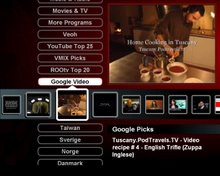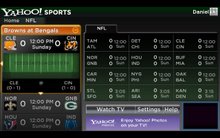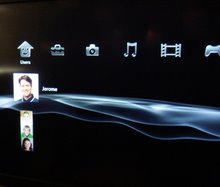Active-TV Ecosystem Developers,
The Issue: Bringing internet-delivered TV-web video to the living room TV requires mastering multiple engineering disciplines and marketing constraints.
Background: Microsoft offers an option for most, but not all, of the pieces needed to form a home entertainment ecosystem.
Behind the scene: Whereas Microsoft is pursuing a Vista-reinforcing digital media strategy, active-TV technology enables a large ecosystem of TVs, PCs and TV-web channels, by offering considerable openness and flexibility in terms of what devices will work well together within the networked ecosystem - including multiple PC operating systems.
A Microsoft supported blog by Chris Lanier, provides more information about Microsoft’s next generation Extender technology: “Microsoft launched there new MCX Partner Site for Pika the other day. Pika is the codename for Media Center Extenders (MCX) v2. “
Following the provided link to the Microsoft’s MCX web site reveals: “Windows Media Center Extender Technology (or "MCX Technology") is platform-independent software that will enable home network connected consumer electronics devices to deliver full, high-definition Media Center experiences.”
Those of you who have been tracking digital media convergence for some time likely remember the first Microsoft Extender device, including its strengths and weaknesses when it was introduced to the market some years ago. Extender technology, now in its second generation (v2) and codenamed Pika, has some similarities, yet important differences, with active-TV technology. Both require the assistance of a networked PC to complete the processing of a TV-web channel; both claim platform-independence for the firmware portion, the portion integrated into the Set-Top Box (STB), TV, or DMA (Digital Media Adapter). It is the significant differences, however, that I will now outline.
First, to what extent is Pika being adopted in the market versus alternative solutions? Recent news from Beijing regarding collaboration between Microsoft and a Chinese TV maker may indicate that the later is considering the use of Pika: "The project focuses on in-home network digital entertainment - how to connect PCs, TVs and the Internet to provide this digital entertainment experience". To be sure, Microsoft Extender technology can be integrated into a TV or STB, but it is noteworthy that so far no European or US developer has introduced such a product. However, there have been announcements from several US and European developers regarding their adding active-TV technology.
The first Media Center Extender device would only operate fully when networked with a Media Center PC, rather than a PC using Windows XP. The Xbox also supports Extender technology but offers reduced functionality when networked with a Windows XP PC. If Extender-enhanced devices were popular they would help drive adoption of the newest premium PC operating systems. However, reduced functionality is not very satisfactory for existing Windows XP users or TV manufacturers that want to sell a networked TV which will work with XP – there are over 100 million licensed XP users. With Pika technology aligned with Vista-based PCs (a small but growing user base) and not the massive Windows XP installed base, the reduced Extender functionality provided to the XP user, may have limited appeal. Of note, Apple-TV (another DMA variant) also operates with a companion networked PC (know as an Extended-PC), but is not ‘keyed’ to a particular version of the Windows operating systems (OS).
In contrast, active-TV technology does not place any restrictions on the version of Windows used by a PC supporting the operation of the networked TV or STB. For this reason, it is easy to see the appeal this flexibility has for the networked TV manufacturer; it allows them to sell a networked TV which accesses internet-delivered TV-web channels to any existing PC owner – not just a subset of new PC owners.
Active-TV technology is also able to support far more TV-web channels than currently accessible through Extender-enabled DMAs. This is because there are lots of ways to build a PC-web page, and equally, many different ways to build a TV-web channel. However the TV-web channels promoted with the Media Center PC, originally known as spotlights, made use of the Windows Media Video (WMV) codec. It is important to underscore that the Extender platforms do not have support for important video codecs such as the popular Adobe Flash (FLV) – however, here is supported for MPEG2.
As a result, a TV-web channel which uses the FLV video codec, such as the recently described YouTube TV-web channel, can not be displayed on an Extender. Adobe Flash Video is likely the most popular video codec in use by video-sharing PC-web sites. Given that a TV-web channel can draw upon the same video database used by the PC-web site, it is much more convenient to use FLV for a TV-web formatted alternative. Active-TV technology works with any video codec and is very flexible in its support for differently formatted TV-web channels.
Microsoft has introduced MCML and WinFX formatting (Media Center Markup Language and WinFX browser apps) for future TV-web channels. Should a TV-web channel developer chose to use these formatting methods they will only be accessible to Extender platforms which have the necessary underlying support – will this mean only a Pika-enabled DMA and a Vista PC? So far, unless an Extender is connected to a PC using the latest version of Windows, there is reduced functionality, such as only supporting basic DLNA operation when used with Windows XP (no TV-web channel access). Slide 4 of Microsoft's WinHec06 presentation indicates that only Vista Premium or Ultimate will support complete Extender functionality. Earlier Windows users can not expect support for “3rd party applications”, which is Microsoft-speak for no TV-web channel access.
Of course, TV-web channel developers may continue to use HTML, Adobe flash and other formatting methods supported by the legacy of browsers used with older PC operating systems. This will likely give them access to the greatest audience, particularly when delivered to the living room TV via active-TV technology.
Lanier’s blog states that Sigma Designs will provide the chip used in the Pika-based Extender v2. ATI provided the chip for the Extender v1. Likely critical to Microsoft’s decision is chip-support for the VC-1 (WMV9) codec. An alternative chip supplier would have been STMicroelectronics – using their ST710x family. Not surprisingly, active-TV technology developers such as Avtrex , Futarque and others, already offer support for Sigma Designs and ST-Micro based TVs and STBs – they also support ATI-based active-TV systems. ATI is a major supplier of chips for the US digital TV market. ST-Micro is major supplier of chips to world-wide TV and Set-Top Box developers. Not to be left out is NXP-based STB developer TeleGent which has also indicated the importance of active-TV technology support. Note that several other STB and TV developers are listed on AMD’s active-TV support page, including: Wyplay, WorldSat, Dream Multimedia and more. Active-TV technology is not owned by any one company, but AMD has been a noticeable user of the technology.
Returning to the recent Beijing news regarding the use of Microsoft technology by a Chinese TV maker, it is not surprising given the developments of leading US and European manufacturers, that their counterparts in China are also evaluating active-TV technology.
Feedback, corrections and comments welcome. Contact me for more information or support with active-TV technology development.
Daniel Mann
Navigate YouTube available at iTunes App Sore
An easy to use iPhone and iPod touch App that enables both new and advanced YouTube users to get the best from YouTube.
Browse video Standard Feeds, Categories, Channels and Playlists. Then organize new videos into your own favorites and playlists. Make playlists private or public. Subscribe to other user's playlists and video collections for future viewing. Subscribe to videos matching search-words.
Look at publicly viewable favorite videos, playlists and subscriptions based on your YouTube friends, family and contacts. Send and receive video links with YouTube contacts via YouTube video messages.
Search for new videos tagged for your language or geographical region, using local keyboard. Explore for new videos via easy switching of user ID to the owner of interesting videos - then explore their world.
All actions are kept in sync with PC, Mac or Apple-TV access to YouTube. Available at Apple App Store.
Browse video Standard Feeds, Categories, Channels and Playlists. Then organize new videos into your own favorites and playlists. Make playlists private or public. Subscribe to other user's playlists and video collections for future viewing. Subscribe to videos matching search-words.
Search for new videos tagged for your language or geographical region, using local keyboard. Explore for new videos via easy switching of user ID to the owner of interesting videos - then explore their world.
All actions are kept in sync with PC, Mac or Apple-TV access to YouTube. Available at Apple App Store.
active-TV technology for PC

Windows PC based home network
Wednesday, June 27, 2007
An update for Microsoft Extender Technology
Labels:
AMD,
Apple-TV,
ATI,
Avtrex,
DMA,
Drem Multimedia,
Extended-PC,
Extender,
Futarque,
MCE,
MCML,
MCX,
NXP,
Pika,
Sigma Designs,
STMicroelectronics,
WorldSat,
Wyplay,
xbox,
Xbox 360
Subscribe to:
Post Comments (Atom)










5 comments:
Thanks for the great information.
Yes, really. And I have faced it. Let's discuss this question.
Thanks for any other informative site. The place else could I am getting that type of info
written in such a perfect way? I have a venture
that I am just now running on, and I've been on the glance out for such info.
Review my site :: http://vimaxmaleenhancements.com
My sis informed me about your website and the way nice it
is. She’s right, I am really impressed with the writing and
slick design. It seems to me you’re just scratching the floor in terms of what you may accomplish,
however you’re off to an ideal begin!
Look into my site ... trying to conceive tips
I'm not capable of see this website correctly on my telephone :(
My weblog: having trouble getting pregnant at 40
Post a Comment